Teaching Thai as a Foreign Language: Mother-Child Teaching Approach
Main Article Content
Abstract
The objective of this article was to study the course content, teaching approach, and management in a high-level Thai language class as part of the project "Teaching Thai Language and Culture, Focusing on Thai-Chinese Translation for International Students" at the Research Institute for Languages and Cultures of Asia. The data were collected by observing classes and interviewing the instructor. The results show that this Thai language class emphasized three points. The first one was teaching learners to use the language like native speakers, including communicating with Thais in various situations, so the course content covers Thai language, society and culture, and topics are arranged from basic to advance. The second one was using the “Mother-Child Teaching Approach”, which is a combination of first and foreign language teaching approaches. The method consists of seven aspects: repetition, frequent practice, observation, correction, love, protection with compassion, and no reproach. This concept combines teaching pedagogy and psychology to provide a guideline for teaching the Thai language to foreign students. The last one was three phases in the teaching management: (a) opening the lesson; (b) during the lesson; and (c) closing the lesson. Students could ask questions at any time in class. The results of this study contribute to the development of new concepts and methods for teaching Thai as a foreign language.
Downloads
Article Details
References
กระทรวงศึกษาธิการ. (2551). หลักสูตรแกนกลางการศึกษาขั้นพื้นฐาน พุทธศักราช 2551. กรุงเทพฯ: ชุมนุมสหกรณ์การเกษตรแห่งประเทศไทย.
กิ่งกาญจน์ บูรณสินวัฒนกูล. (2561). กลวิธีการสอนภาษาไทยเพื่อการสื่อสารสำหรับผู้เรียนภาษาไทยในฐานะภาษาต่างประเทศ. วารสารศิลปศาสตร์, 18(2), 164-178.
ปรียา หิรัญประดิษฐ์. (2545). สถานภาพการเรียนการสอนภาษาไทยให้แก่ชาวต่างประเทศ ในประเทศไทย (รายงานผลการวิจัย). นนทบุรี: สาขาวิชาศิลปศาสตร์ มหาวิทยาลัย สุโขทัยธรรมาธิราช.
พระพรหมคุณาภรณ์ (ป.อ. ปยุตฺโต). (2558). พจนานุกรมพุทธศาสตร์ ฉบับประมวลธรรม. กรุงเทพฯ: ผลิธัมม์.
มิรินด้า บูรรุ่งโรจน์. (2561). แนวทางการจัดการเรียนการสอนภาษาไทยสำหรับเยาวชนไทยเชื้อสายมลายูในพื้นที่จังหวัดชายแดนภาคใต้. ใน ศิริรัตน์ นีละคุปต์ อุบลวรรณ เปรมศรีรัตน์ และณัฐมน โรจนกุล (บรรณาธิการ), การจัดการศึกษาแบบทวิภาษา-พหุภาษาในจังหวัดชายแดนภาคใต้ (น. 42-77). นครปฐม: ศูนย์ศึกษาและฟื้นฟูภาษาและวัฒนธรรมในภาวะวิกฤต สถาบันวิจัยภาษาและวัฒนธรรมเอเชีย มหาวิทยาลัยมหิดล.
รัชดา ลาภใหญ่. (2559). แนวทางและข้อควรปฏิบัติในการสอนภาษาไทยในฐานะภาษาต่างประเทศให้แก่นักศึกษาจีนอย่างมีประสิทธิผล. วารสารมนุษยศาสตร์และสังคมศาสตร์ มหาวิทยาลัย รังสิต, 12, 37-48.
ราชบัณฑิตยสถาน. (2556). พจนานุกรม ฉบับราชบัณฑิตยสถาน พ.ศ. 2554. กรุงเทพฯ: ราชบัณฑิตยสถาน.
ราชบัณฑิตยสถาน. (2557). พจนานุกรมศัพท์ภาษาศาสตร์ (ภาษาศาสตร์ประยุกต์) ฉบับราชบัณฑิตยสถาน. กรุงเทพฯ: ราชบัณฑิตยสถาน.
รุ่งฤดี แผลงศร. (2561ก). ศาสตร์การสอนภาษาไทยในฐานะภาษาต่างประเทศ. กรุงเทพฯ: โรงพิมพ์แห่งจุฬาลงกรณ์มหาวิทยาลัย.
รุ่งฤดี แผลงศร. (2561ข). หลักการจัดการเรียนการสอนภาษาไทยในฐานะภาษาต่างประเทศ. วารสารวิชาการศึกษาศาสตร์, 19(2), 1-13.
วิษณุ วงศ์สินศิริกุล. (2559, 20 พฤษภาคม). One belt one road กับโอกาสของไทย. ประชาชาติ ธุรกิจ. สืบค้นจาก http://www.prachachat.net/news_detail.php?newsid=1463636522.
สมพงศ์ วิทยศักดิ์พันธุ์. (2548). การสอนภาษาไทยในฐานะภาษาต่างประเทศ. วรรณวิทัศน์, 5, 215-261.
สำนักงานราชบัณฑิตยสภา. (2560). พจนานุกรมศัพท์ภาษาศาสตร์ (ภาษาศาสตร์ทั่วไป) ฉบับราชบัณฑิตยสภา. กรุงเทพฯ: สำนักงานราชบัณฑิตยสภา.
สุมนทิพย์ วัฒนา. (2561). การศึกษาแรงจูงใจและกลวิธีการเรียนรู้ภาษาไทยในฐานะภาษาต่างประเทศของนักศึกษาปริญญาตรีชาวจีนในมหาวิทยาลัยวิจัยไทย (วิทยานิพนธ์ปริญญามหาบัณฑิต), มหาวิทยาลัยมหิดล, นครปฐม.
สุรีย์วรรณ เสถียรสุคนธ์. (2554). การสอนภาษาไทยให้แก่นักศึกษาชาวจีน: สภาพ ปัญหา และแนวทางแก้ไข. วารสารมนุษยศาสตร์, 18(1), 127-140.
เอกรินทร์ สี่มหาศาล และคณะ. (2552). กระบวนการจัดทำหลักสูตรสถานศึกษา แนวคิดสู่ปฏิบัติ. กรุงเทพฯ: บุ๊คพอยท์.
Anderson, R. C. (1994). Role of the reader's schema in comprehension, learning, and memory. In R. B. Ruddell, M. R. Ruddell, & H. Singer (Eds.). Theoretical models and processes of reading (pp. 469-482). Newark, DE, US: International Reading Association.
Asher, J. J. (1983). Learning another language through actions: the complete teacher's guidebook. Los Gatos, Calif: Sky Oaks Productions.
Bandura, A. (1977). Social learning theory. Englewood Cliffs, NJ: Prentice-Hall.
Bloom, B. S. (1956). Taxonomy of educational objectives: the classification of educational goals. New York: David McKay.
Chimprabha, M. (2015, June 14). Thai the language of choice for Chinese students in Yunnan. The Nation. Retrieved from http://www.nationmultimedia.com/national/Thai-the-language-of-choice-for-Chinesestudents-i-30 262309.html.
Chomsky, N. (1959). Review of Skinner’s Verbal Behavior. Language, 35(1), 26-58.
Krashen, S. D. (1982). Principles and practice in second language acquisition. Oxford: Pergamon Press.
Piaget, J. (1976). Piaget’s theory. In B. Inhelder, H. H. Chipman & C. Zwingmann (Eds.), Piaget and his school: A reader in developmental psychology (pp. 11-23). New York: Springer-Verlag.
Skinner, B. F. (1957). Verbal behavior. New York: Appleton-Century-Crofts.
Vygotsky, L. S. (1978). Mind in society: The development of higher psychological processes. Massachusetts: Harvard University Press.
Yin, H., Ruangkanjanases, A., & Chen, C. (2015). Factors affecting Chinese students' decision making toward Thai universities. International Journal of Information and Education Technology, 5(3), 189-195.
Zhang, H. (2017, September 20). More Chinese students turning to Belt and Road countries. Global Times. Retrieved from http://www.globaltimes.cn/content/1067361.shtml.

